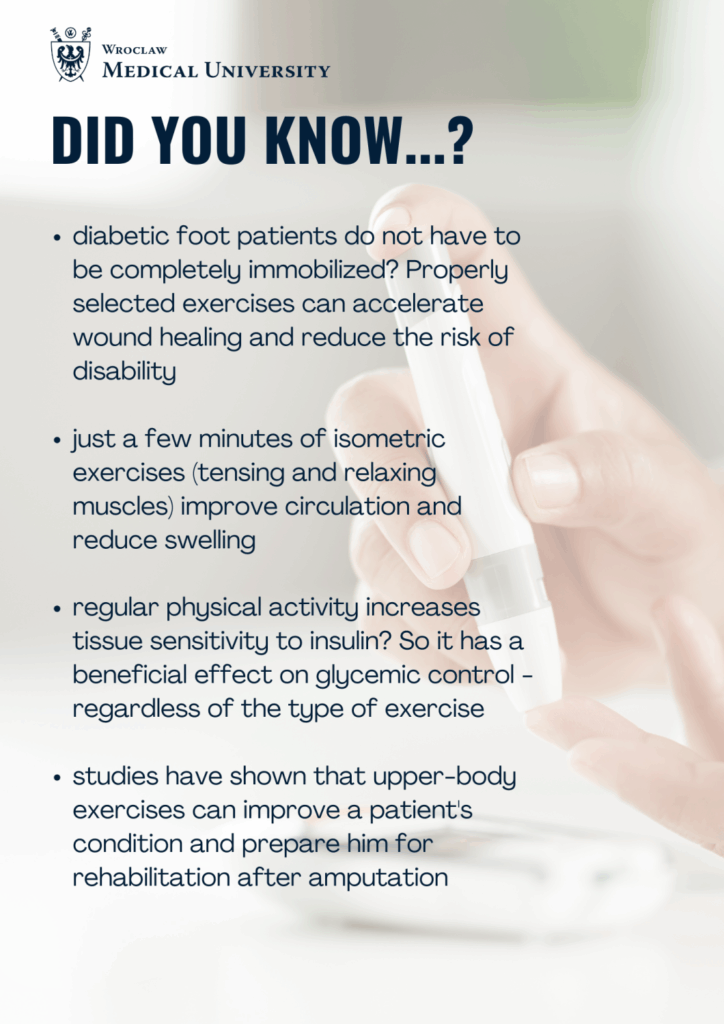In diabetes, physical activity is an essential part of behavioral treatment – it improves glycemic control, supports the cardiovascular system, reduces inflammation, and, consequently, reduces the risk of chronic complications. But what to do when one of the most serious complications arises: the diabetic foot? Ulcerations, deformities, and infections rule out physical activity. For years, there was a belief that the only safe course of action in such a situation was to put weight on the affected foot, which significantly limits the patient’s activity. Today, more and more studies are challenging this scheme, showing that properly selected exercise can be an ally in healing, not a threat.
Why is movement so important?
Diabetic foot is not just a local problem – it is a complication that radically changes the life of a person with diabetes. Patients with diabetic foot often not only relieve pressure on the affected limb, which is indeed necessary, but also limit their overall activity due to pain, risk of injury, or fear of worsening the condition. This, in turn, leads to muscle weakness, impaired circulation, and a general physical decline in fitness.
Meanwhile, there are several exercises that not only can most of these people safely perform, but for which several benefits have been demonstrated:
- systemic – increasing insulin sensitivity, improving heart and respiratory function,
- local – stimulating blood and lymph circulation, promoting angiogenesis, relieving inflammation, improving ulcer healing,
- functional – reducing muscle atrophy, joint stiffness, and consequently improving balance, which is crucial for patients’ independence during and after treatment.
What does the research show?
The review, prepared by researchers from the Wroclaw Medical University and Gdański Uniwersytet Medyczny (Medical University of Gdańsk), integrates knowledge from both basic and clinical research, as well as evidence-based recommendations. The authors demonstrate that functionally tailored exercises not only do no harm, but can support the therapy of the diabetic foot by improving the integration of the musculoskeletal system and stimulating spontaneous regeneration processes. The conclusions are clear: well-planned, individualized exercises should be an integral part of the therapeutic process for the complication above at every stage. In addition to accelerating the healing of lesions, exercise prepares patients for further stages of management.
Which exercises are safe?
It is not about intensive workouts, but about individually tailored programs including, for example:
- the use of an aquatic environment or specialized rehabilitation equipment.
- lower limb exercises in a sitting or lying position due to the need to relieve pressure on the affected area (e.g., exercises that increase the range of motion in the joints of the limbs, which at the same time have an anti-edema and anti-thrombotic effect,
- isometric exercises (tensing the muscles for a few seconds and then relaxing them),
- upper body exercises that improve fitness and prepare for eventual rehabilitation after amputation,
“There is no one particular group of exercises that is “most important.” Each type has its role in the patient’s therapy,” explains Edyta Sutkowska, MD. – “The simplest sets are standard to all patients, but the exercise program should always be selected individually.”
The authors of the publication also emphasize the potential role that virtual forms of rehabilitation support, which are at the stage of conceptual research, can play in diabetic foot therapy.
Balance instead of immobilization
The key, then, is to find a balance between the necessary relief of the affected foot and the need to meet the need for activity within the range available to the patient (each individual). In practice, this means that a patient with diabetic foot ulceration or deformity does not need to be confined to a bed or wheelchair. He can, and even should, perform a range of exercises with local and systemic effects.
“As an absolute rule, we do not exercise in the case of sepsis or other general contraindications that the attending physician may determine on any given day”, Dr. Sutkowska stresses. “We also do not stress the ulcer or foot in the “active phase” of Charcot.”
What does this change for patients?
The new approach shows that a diabetic foot does not have to mean giving up activity altogether. On the contrary, rehabilitation is becoming an integral part of therapy. This is a significant change not only in treatment, but also in patients’ attitudes: movement gives them a sense of influence throughout the disease, improves quality of life and reduces the risk of disability.
A team from the Wroclaw Medical University and Medical University of Gdansk prepared parallel brochures for patients and their medical caregivers containing exercise suggestions for patients with this dangerous complication.

This material is based on an article:
On the Merits of Targeted and Individualized Physical Exercise in Persons with Diabetic Foot Disease—From Controversies to Consensus
Authors: Edyta Sutkowska, Anna Korzon-Burakowska, Karolina Biernat
DOI: 10.3390/biomedicines13071752